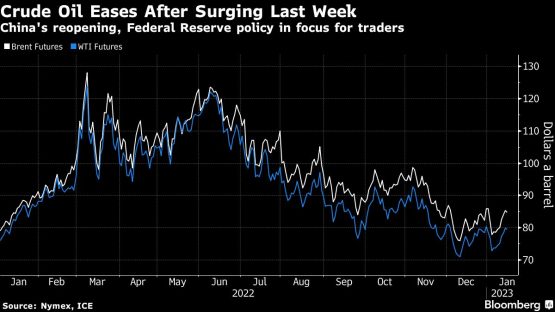
Oil dropped for the first time in eight sessions as traders took stock of a complex outlook for worldwide demand, with China’s reopening delivering a lift while other parts of the global economy slow.
West Texas Intermediate fell toward $79 a barrel after rallying more than 8% last week. China ditched Covid-19 curbs in late 2022 after years of strict lockdowns. That’s set to improve economic activity and mobility, with analysts forecasting oil demand in the top crude importer will likely hit a record.
Crude has had a bumpy start to the year, collapsing in the opening week before rebounding. In addition to China’s swift pivot, support for crude prices in recent sessions has come from growing expectations that the Federal Reserve is now nearing an end to rate hikes, and a weakening dollar. Traders are also tracking the impact of sanctions on Russian oil and product flows.
“While China was the primary driver of commodities last week, traders’ sentiment was also boosted by the expectation that the Fed will slow down on rate hikes,” said James Whistler, managing director of brokerage Vanir Global Markets Pte in Singapore. “We see upside, but be wary of a Lunar New Year lag,” he said, referring the nationwide break next week.
This week, investors will dissect market outlooks from the Organization of Petroleum Exporting Countries as well as the International Energy Agency, which may highlight risks to consumption from slowing growth in the US and Europe. The cartel turns in its analysis on Tuesday, with the IEA’s the next day. Extra commentary may come from the World Economic Forum in Davos.
| Prices: |
|---|
|
Time spreads show a mixed picture. Brent’s prompt spread — the difference between its two nearest contracts — is in contango, a bearish pattern that indicates ample near-term supply. Still, the three-month differential for the global benchmark is in the opposite, backwardated structure.
© 2023 Bloomberg







